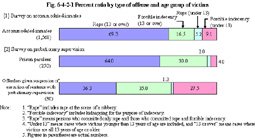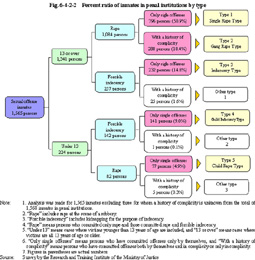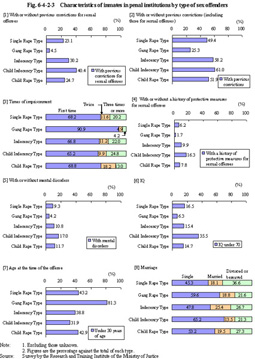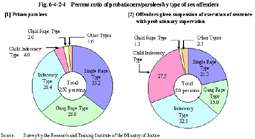| Previous Next Index Image Index Year Selection | |
|
|
1 Reality of sex offenders
We will analyze the characteristics of sex offenders based on the results of the fact-finding survey.
(1) Survey targets
The targets of the survey on inmates in penal institutions were 1,568 sex offenders accommodated in penal institutions nationwide as of June 1, 2005 (hereinafter referred to as "accommodated inmates" in this Section). The targets of the survey on probationary supervision were 330 sexual offense probationers/parolees newly received to probation offices nationwide between July 1 and December 31 of 2004 (hereinafter referred to as "probationers/parolees" in this Section).
Fig. 6-4-2-1 shows the percent ratio of survey targets by type of offense and age group of victims. Fig. 6-4-2-1 Percent ratio by type of offense and age group of victims (2) Analysis by type of sex offenders
In order to clarify the reality of sex offenders, we will analyze and examine the characteristics of each type of sex offender.
We categorized sex offenders in three steps. Firstly, we divided sex offenders into two groups by whether their victims include persons younger than 13 years of age or not. Next we divided them into two groups by whether their offenses include rape (including rape at the scene of a robbery; hereinafter the same in this Subsection) or are only forcible indecency (including kidnapping for the purpose of indecency hereinafter the same in this Subsection). Then we further divided them into two groups by whether they have committed offenses only by themselves or they have committed offenses both only by themselves or in complicity. Among eight types obtained by the above-mentioned categorization, we defined the top five types with larger percent ratios as the five major types of sex offenders. 1) Single Rape Type Single offenders whose victims do not include persons younger than 13 years of age and whose offenses include rape Example of Single Rape Type - A case of rape by breaking into a residence committed by a neighbor The perpetrator intended to rape the victim, who lives next door alone with her mother, in the absence of the mother. He broke into her residence from the bathroom window at night when the mother was out, threatened her with a knife and raped her. 2) Gang Rape Type Offenders whose victims do not include persons younger than 13 years of age, whose offenses include rape, and who have committed offenses only in complicity. Example of Gang Rape Type - A case of gang rape by bringing the victim into a warehouse The perpetrator colluded with four acquaintances and deceived the victim, who just passed by, by saying, "We came from Osaka and don't know the way. Could you tell us?" He persistently asked her to tell them the way, took her in his car, brought her into a warehouse, and raped her in a group. 3) Indecency Type Single offenders whose victims do not include persons younger than 13 years of age and whose offenses are only forcible indecency Example of Indecency Type - A case of forcible indecency on the street The perpetrator saw the victim, who was on her way back with her friend, and followed her, thinking that he could molest her when she was alone. When she parted with her friend, he chased her into a vacant lot nearby, clung from behind to push her down, and molested her. 4) Child Indecency Type Single offenders whose victims include persons younger than 13 years of age and whose offenses are only forcible indecency Example of Child Indecency Type - A case of forcible indecency committed by an elementary school teacher The elementary school teacher came to be strongly interested in naked bodies of girls from elementary school students to high school students, while watching images of naked women on the Internet. He locked the entrance of the math classroom when the victim, who was a student of his class, was changing her clothes, and molested her. 5) Child Rape Type Single offenders whose victims include persons younger than 13 years of age and whose offenses include rape Example of Child Rape Type - A case of rape by pretending to ask the way The perpetrator saw the victim, who was on her way back from school, showed her a picture of a dog, and took her in his car by saying, "I'm looking for this dog. Could you tell me the way?" He unclothed her in his car, which he parked on a farm road near a mountain, took pictures of her with his camera, and raped her. a. Analysis of inmates in penal institutions by type
Fig. 6-4-2-2 shows the percent ratio of inmates in penal institutions by type. The Single Rape Type was the largest, accounting for more than 50%, followed by the Gang Rape Type and Indecency Type.
Fig. 6-4-2-2 Percent ratio of inmates in penal institutions by type Fig. 6-4-2-3 shows the characteristics of inmates in penal institutions by type.Characteristically, the percentage of those with previous convictions for sexual offenses and those intellectually disabled was high for the Child Indecency Type and the percentage of first-time inmates and those who were younger than 30 years of age at the time of the offense was high for the Gang Rape Type. Fig. 6-4-2-3 Characteristics of inmates in penal institutions by type of sex offenders b. Analysis of probationers/parolees by type
Fig. 6-4-2-4 shows the percent ratio of probationers/parolees by type of sex offenders.
Fig. 6-4-2-4 Percent ratio of probationers/parolees by type of sex offenders Fig. 6-4-2-5 shows problems of each type of probationers/parolees in their daily life observed by probation officers in charge of them.Prison parolees categorized into the Child Indecency Type showed notable characteristics that they are shy and lacking self-confidence and are apt to be under a lot of stress. Fig. 6-4-2-5 Problems of parolees/probationers in their daily life by type of sex offenders (3) Cases depriving minors of their lives
A series of serious sexual offenses targeting minors have occurred in recent years, which stunned the whole society. Therefore, we analyzed nine inmates in penal institutions who have been serving their sentence for offenses including rape causing death and whose victims were minors younger than 13 years of age.
Among those nine inmates, one committed two cases, victimizing two persons, and the other eight committed one case with one victim each. a. Sentencing, etc.
Seven were sentenced to life imprisonment with work and two were sentenced to imprisonment with work with a definite term (for 20 years and 18 years). Three were granted reduction of the sentence due to diminished capacity in the trial.
b. History of delinquency and medical history, etc.
With regard to a history of delinquency related to sexual offenses, one had been committed to a juvenile training school for forcible indecency and rape resulting in injury, etc. when he was a junior high school student. Another had been placed under probationary supervision due to rape after graduating from a junior high school.
For a history of other types of delinquency, two had shown a propensity for stealing since they were elementary school students, and one had had connection with Boryokudan members since he was a junior high school student. For medical history, etc., one had suffered from mental disorders and alcohol addiction, three were or were suspected to be intellectually disabled, and one had suffered from alcohol addiction. c. Age at the time of the offense
At the time of the offense, one was in his teens and twenties (the one who committed two cases), three were in their twenties, three were in their thirties, one was in his forties, and one was in his fifties.
d. Occupation at the time of the offense
One was unemployed and the other eight were employed. Three were company employees, one was a driver, two were construction workers, one was a plasterer, and one was a cook.
e. Victims
Victims were ten girls. Two were 7 years old, three were 8, two were 9, one was 10, and two were 11.
Of these ten girls, eight had no acquaintance with the offender. One was a child of an offender's sister, and another was a neighbor. f. Sites of the offense
The place where the offender first encountered the victim was on the street for six cases, outdoors other than on the street for two cases, at a victim's residence for one case and at a perpetrator's residence for one case. In all cases where victims had no acquaintance with offenders, the first contact was made outdoors. The murder was carried out at a perpetrator's residence in three cases, in mountains in three cases, outdoors other than in mountains in two cases, and indoors other than at a perpetrator's residence in two cases.
g. Modus operandi
At the first contact, the offender spoke to the victim by asking to tell him the way in five cases and directly had bodily contact with the victim in five cases. The murder was carried out with bare hands, such as by strangling the victim by throat, in eight cases.
h. Motives
In five cases, the murder was carried out both for pursuing the offense and for preventing the offense from being discovered, and in five cases, just for preventing the offense from being discovered. In four cases, the victim's body was abandoned.
i. Conclusion
In terms of personal quality, five had some mental disorders, alcohol addiction, or intellectual disabilities, but the other four did not have any of these.
Some started to commit sexual offenses at a young age, but some had no previous convictions for sexual offenses. Some committed delinquency such as theft at a young age instead of committing sexual offenses, and those without a history of delinquency also had some problems including alcohol addiction. Most of these nine inmates had no acquaintance with their victims, but there was a case where the victim was a close relative. In most cases, the offenders targeted a victim when she happened to pass by alone, but got upset at her resistance and ended up robbing her young life extremely easily only out of selfish motives to hide their offenses. Based on these cases, it can be concluded that sex offenders targeting children often have problems in their personal quality and there exist a few persons that may commit a serious offense depending on the circumstances at the time of the offense. |




